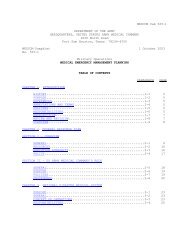(MCD) Guidelines
(MCD) Guidelines
(MCD) Guidelines
You also want an ePaper? Increase the reach of your titles
YUMPU automatically turns print PDFs into web optimized ePapers that Google loves.
<strong>Guidelines</strong> for Military Mass Casualty Decontamination Operations<br />
During a Domestic HAZMAT/Weapon of Mass Destruction Incident<br />
completed decontamination and are seeking medical care. Every effort should be<br />
made to ensure that health care professionals and officials are intimately involved<br />
with and part of <strong>MCD</strong> planning, training and operations. In addition, an <strong>MCD</strong><br />
approach that only considers decontamination from the incident site alone will not be<br />
effective in the face of casualties self-presenting to health care facilities rapidly and<br />
in high numbers.<br />
The principles of decontamination should guide all processes and priorities when<br />
planning and performing decontamination. 15 Table 5 compares the fundamentals<br />
and priorities listed in Field Manual 3-11.5 for military operations to those listed in<br />
the DHS TCL/UTL and USACBRNS/ECBC guidelines for civilian operations. 1,11,15<br />
Note that the three lists complement each other. The DHS’ TCL/UTL and<br />
USACBRNS/ECBC recommendations are more operational. The FM 3-11.5<br />
recommendations are more academic. Table 6consolidates these basic principles<br />
and associates them to specific USACBRNS collective tasks.<br />
Table 5: Comparison of the Decontamination Fundamentals Between FM 3-11.5, DHS<br />
TCL/UTL, and the USACBRNS/ECBC <strong>Guidelines</strong>, Volumes I & II.<br />
FM 3-11.5 DHS TCL/UTL* USACBRNS/ECBC*<br />
1. Speed. Personnel should<br />
conduct decontamination<br />
operations as quickly as<br />
possible. Direct exposure to<br />
CBRN agents or toxic industrial<br />
materials will create casualties<br />
and could be fatal within<br />
minutes. The sooner equipment<br />
is decontaminated, the less likely<br />
it is to absorb the agent or<br />
spread to other surfaces.<br />
2. Need. Decontaminate only what<br />
is necessary. Personnel have a<br />
limited amount of resources<br />
available and should expend<br />
resources only where they are<br />
needed.<br />
3. Priority. Decontaminate the<br />
most essential items first;<br />
foremost will be the skin if<br />
contact occurs. Once wearing<br />
protective equipment, personnel<br />
should begin decontamination<br />
operations on clothing,<br />
equipment, and vehicles.<br />
4. Limited Area. Personnel should<br />
perform decontamination near<br />
the area where the<br />
contamination occurs. This limits<br />
the spread of contamination to<br />
other areas and reduces the<br />
time spent traveling.<br />
1. Test and identify all likely<br />
hazardous substances onsite.<br />
2. Establish decontamination<br />
site for victims.<br />
3. Implement emergency<br />
decontamination operations.<br />
4. Screen affected persons.<br />
5. Decontaminate victims<br />
exposed to CBRNE materials.<br />
6. Implement plans, procedures,<br />
and protocols to ensure on-site<br />
individual gross<br />
decontamination of persons<br />
and household pets affected by<br />
the incident.<br />
7. Readily identify people who<br />
have received gross<br />
decontamination.<br />
8. Implement technical<br />
decontamination for injured,<br />
contaminated victims.<br />
9. Monitor exit points for<br />
contaminant movement outside<br />
the isolation zone.<br />
10. Monitor clean areas within<br />
the contamination control line.<br />
1. Disrobing is the most critical<br />
step and removes up to 90% of<br />
physical contamination.<br />
2. Neither should disrobing nor set<br />
up of a high-volume, lowpressure<br />
water shower be<br />
delayed to introduce a soap<br />
water solution or to set up<br />
tents.<br />
3. Triage victims for<br />
decontamination before the<br />
water shower.<br />
4. Victims should be washed<br />
between 30 seconds and 3<br />
minutes.<br />
5. Decontamination of chemical<br />
vapors, biological material or<br />
radiological substances can be<br />
aided by rubbing hands or<br />
cleans cloths across the skin.<br />
6. Rubbing should start with the<br />
head and proceed down the<br />
body to the feet.<br />
7. Use victim observation areas to<br />
watch for delayed symptom<br />
onset.<br />
8. Perform additional secondary<br />
decontamination as<br />
necessary.<br />
* These <strong>Guidelines</strong> use the term “casualty” instead of “victim” or “patient.” However, cited references may use<br />
the terms “victim” and/or “patient.” These terms will not be changed to “casualty” when quotes are taken from<br />
the cited references.<br />
26 Original



